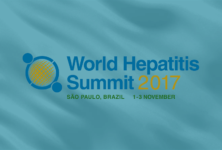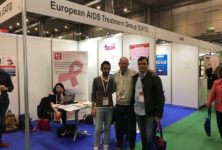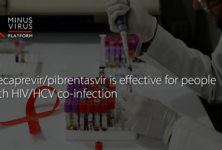Apathy and political expedience have shaped the Kremlin’s frozen-in-time views on the virus. Will officials finally act to prevent a national health crisis?
Moscow, November 22, 2016 — Max Malyshev first started using drugs as a teenager in Tver, an industrial city north of Moscow, mostly because it “was just fun,” the 39-year-old said. He grew up in what he called a “typical Russian family,” one where the “father drinks too much” and everyone suffered in the face of an uncertain future in post-Soviet Russia. He was looking for an escape. So, at age 16, he began injecting amphetamines and heroin. Eventually, he moved on to “krokodil,” a locally produced, opioid-based drug nicknamed after the reptile for the skin ulcers it frequently produces that resemble scales. Malyshev spoke of the freewheeling parties he attended, where no one worried about drawing drugs from the same vial.
In 1997, after Malyshev was arrested for dealing drugs, the police forced him to take an HIV test, a standard government policy. His results were positive. But when he was released, he found no reason to change his lifestyle. “What option was there?” he asked. After all, as he put it, “there were barely any services available” to treat his addiction. Antiretrovirals to treat the disease funded by the government were offered to him in theory. But with a chaotic lifestyle of daily drug use, cold indifference from health-care providers who viewed him as a “junkie,” and a near total absence of addiction services, access to care for Malyshev was effectively nonexistent.
Today, there are an estimated 1.5 million people who have been diagnosed with HIV or AIDS in Russia, which has a population of 140 million. Although the spread of HIV has been stemmed in sub-Saharan Africa, in Russia the rate of HIV infection is rising 10 to 15 percent each year — a pace comparable to the infection rate in the United States in the 1980s, when the basic biology of HIV was poorly understood and the antiretroviral drugs used to treat the disease were years away from discovery. And the uncontrolled rise of the disease is unlikely to abate in the foreseeable future, as the Russian government firmly rejects scientifically tested policies out of apathy and political expedience.
The Soviet Union didn’t even begin to officially report HIV infections until 1987. After the fall of the Soviet Union in 1991, heroin and other injectable drugs became easily accessible to Russians. In the late 1990s and onward, as trafficking routes from Afghanistan through the porous borders of former Soviet Central Asia and into Russia further developed, infection rates across the region steadily rose. The drug trade from Afghanistan to Russia has since morphed into a multibillion-dollar illegal economy for traffickers, accounting for about 25 percent of all Afghan heroin — and leaving a wake of corruption and infection in its trail. Russia, the top market, has been hit the hardest. In 2014, the most recent year of data available, the Russian Federal AIDS Center found in that intravenous drug use accounted for 58 percent of HIV infections and the rest from sexual transmission.
Despite the startling statistics, the Kremlin refuses to embrace the globally accepted, evidence-based strategies that reduce the spread of the epidemic among drug users. And the government’s defiance in its policy, according to health experts, is almost certain to result in increased cases of HIV infections. As Michel Kazatchkine, the U.N. secretary-general’s special envoy on HIV/AIDS in Eastern Europe and Central Asia, said in an interview: “On the drug side [of its HIV response], Russia has not changed.… [If anything,] it is toughening.”
Central to an evidence-based response to intravenous-fueled HIV is the use of opioid substitution therapy (OST), which replaces intravenous drug usage with an opioid-based oral medication like methadone or buprenorphine. These medications are prescribed by a physician and do not induce a high. By reducing the use of needles and allowing drug addicts to have a more stable life, it has been shown to substantially decrease the transmission of HIV — for which the Joint U.N. Program on HIV/AIDS and the World Health Organization (WHO) declared it an “essential” tool in 2004. The use of OST reflects an increasingly popular philosophy among global public health leaders of “harm reduction” — where the focus is centered on preventing the negative effects of drug use rather than trying to prevent drug use itself. But the Russian government views OST as merely replacing one addiction with another. In 1997, it made its use illegal, punishable with up to 20 years in prison.
Needle exchange programs in Russia — another pillar of harm reduction that has been proved to decrease HIV transmission and save lives in programs across the world — currently receive almost no funding. Until 2009, needle exchange programs had been widely available, mostly with financing from the Global Fund, a public-private consortium that is the world’s largest financier of HIV projects. But when that agency’s money was withdrawn in 2010 — largely because Russia had achieved the status of a high-income country — Moscow did not replace funding, and the number of needle exchanges in the country dropped from 80 to 10.
In lieu of these kinds of programs that have worked in other countries, the Russian government offers drug addicts who are trying to quit options that are ineffective and difficult to access, said Anya Sarang, the president of the Andrey Rylkov Foundation, a Russian nongovernmental organization (NGO) focused on harm reduction. “Most government-funded services are only in detoxification, allowing people to briefly withdraw from their addiction and then to return to their life situation,” Sarang said. “Private rehabilitation services have grown, where people can go after detoxification, but mostly you can only use them if you have money. If you don’t have money, there are still basically no options.”
Many Russian health providers and bureaucrats disagree with the government’s position. But because speaking out could jeopardize their jobs, few do so. A lung disease specialist in Moscow who asked to remain anonymous said Russia knows how to rein in its HIV epidemic. “Intravenous drug users make up most of my patients. To treat them — and for their HIV, for the tuberculosis that usually comes with it — they need to take pills every day,” the specialist said. “The only reliable way to bring them in is with OST. Without it, patients only come when they are feeling deathly ill and leave as soon as they can get their next fix.”
Even compared to authoritarian countries, Russia stands out for its refusal to implement harm reduction in drug use. China and Iran — countries that traditionally focus on the enforcement aspect of drug control — have established methadone maintenance programs. China’s Center for Disease Control and Prevention reported that since its program began in 2003, it has grown to support 170,000 injection drug users and estimates that at least 13,000 HIV drug infections have been averted.
Among the former Soviet countries — most of which also face high rates of HIV and drug addiction — only Turkmenistan and Uzbekistan have not made OST available. In neighboring Ukraine, where methadone has been legalized, the rate of HIV transmission growth decreased, particularly among young people who inject drugs, for whom infection rates decreased more than fivefold between 2007 and 2013, according to the most recent statistics from the International HIV/AIDS Alliance in Ukraine. Official figures for the entire country have not been available since the annexation of Crimea and the outbreak of war in eastern Ukraine, but the turbulent two years are believed to have sent infections rates back up.
Russia’s zero tolerance drug policy reflects, in part, a strain of social conservatism running through the country that views drug use as a personal moral failing. “Methadone is considered in the same category as tolerance to gays — rotten Western practices,” said Sergey Lukashevsky, the director of the Sakharov Center, a Moscow-based facility for discussion on Russian culture and history.
This perspective — which paints the problem as a foreign-imported plot — is inflamed to build support for the government. Victor Ivanov, the former director of the Russian Federal Drug Control Service (FSKN), explained his organization’s position on OST in a 2015 statement. “Customers of this murderous therapy are prisoners chained by their own chemical handcuffs,” Ivanov said. “Attempts to impose its legalization in Russia are not associated with therapeutic objectives … [but] with the political ambitions of the global drug lobby and the economic interests of pharmaceutical companies.”
But the FSKN itself may have been a big part of the problem. Lukashevsky said the FSKN has long made policies “with an official aim of fighting drug dealing but with an unofficial aim of self-preservation.” The drug control service has jockeyed against other agencies attempting to win favor and resources from the government, taking actions that gain headlines but are in fact highly ineffective. The agency has arrested bakers for suspicion that their poppy seeds are used in drug production, has restricted opioid-based pain control in palliative care facilities, and has removed from bookstores literature perceived to promote drug use, such as the writing of American novelist William Burroughs.
In April, the FSKN was absorbed into the Ministry of Internal Affairs, and Ivanov, a former KGB colleague of Russian President Vladimir Putin, was removed from his post. The new leader of the drug agency, career cop Maj. Gen. Andrey Khrapov, has a history of being more pragmatic than his predecessor, who followed a hard line on drugs. But with health-care budgets slashed across Russia as the country has slumped into economic crisis, Moscow’s strict stance on methadone looks set to continue.
With the number of those infected continuing to rise, the government has finally decided to respond. Russia has expressed its aim to implement the newest strategy recommended by the WHO in 2015 to limit the spread of HIV: “treatment as prevention.” This policy would provide all HIV/AIDS patients with antiretroviral drugs — not only for those who show progression in their disease. In March, Russia tentatively announced plans to increase its coverage from 17 to 60 percent of HIV/AIDS patients, and Veronika Skvortsova, the health minister, promised an extra $315 million in funding.
But without the use of both OST and the widespread needle exchange programs to support the expanded coverage, Russia will have difficulty curbing its epidemic, predicts David Wilson, the director of the World Bank’s global HIV/AIDS program. “Russia’s AIDS investments will not be optimal unless they focus on all three core interventions,” Wilson said.
And Russia faces more hurdles in containing its HIV/AIDS growth. Russia is an outlier among the BRICS countries — Brazil, Russia, India, China, and South Africa — in the high cost of antiretroviral medications. The prices of the standard first-line regiment medications are 3.2 times the average of prices for middle-income countries, according to the World Bank, in part because many of these medications are imported and the Russian ruble has been falling sharply in the past year. And the Russian ban on “propaganda of nontraditional sexual relations among minors,” or the so-called LGBT propaganda law, enacted in 2013, has also been linked to a rise in HIV among men who have sex with men. Information about the prevention of HIV directed toward this group is forbidden, and individuals increasingly avoid seeking testing and treatment owing to severe discrimination. One survey from St. Petersburg, conducted between 2012 and 2015 by the Russian human rights NGO Phoenix Plus, found that the prevalence of HIV among men who have sex with men had increased from 10 percent in the year before the law was enacted to 22 percent in 2015.
Max Malyshev, for his part, managed to find help for his addiction a few years after his diagnosis. An initial experience with the state-funded detoxification system did not go well, but friends brought him to private counseling and 12-step programs that eventually stuck, and he subsequently pursued care for his HIV. Now, at age 39, he works with the Andrey Rylkov Foundation in the needle exchange program in Moscow, the only one left in the capital. But even the foundation has come under further pressure of late; it was labeled a foreign agent this year under Russia’s restrictive laws that seek to stigmatize NGOs that rely on foreign contributions.
After decades of experiencing Russia’s frozen-in-time drug policy, Malyshev said he has “stopped thinking about hoping” that harm reduction will arrive anytime soon. But he laughs a lot as he works, clearly enjoying what he does. He knows that even if it is only a dent in the massive and growing crisis, he, at least, is making a difference.
By Ryan Hoskins


 ПОИСК ПО САЙТУ
ПОИСК ПО САЙТУ  поиск по ресурсному центру
поиск по ресурсному центру 



